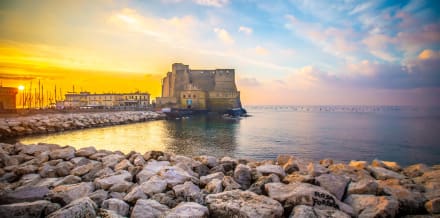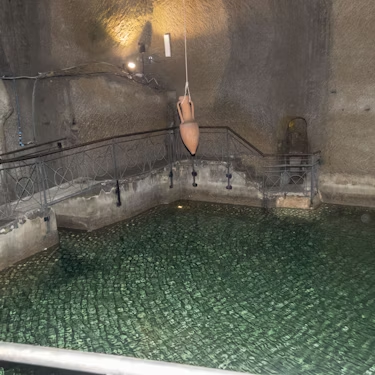More about: Naples in 5 Day: a guidebook for getting the most out of your visit
A 5-day trip is more than enough time for everything there is to see and do in Naples. Not only that, but you can also take advantage of the trip to visit nearby places like Pompeii or the Amalfi Coast, two places to get to know the history and tradition of the area.
Naples is a city full of Roman ruins and with a religious culture that is represented in the many churches there. Of course, it's also a great place to sample some of **Italy'**s finest cuisine. However, its streets can be narrow and even a bit chaotic, so follow this itinerary to avoid getting lost and see everything.
Day 1: Tour the historic centre of Naples

For your first day in Naples I suggest you to visit the old town and three very important religious buildings in the city: the Cathedral, the Basilica of Santa Maria Maggiore and the Chapel of San Salvatore. Don't worry because you will also have time to stroll around its streets.
Start the day at Piazza Garibaldi
Start your trip in Piazza Garibaldi, a very central location where you'll also find the train station and several bus stops and the metro line 1, so it's easy to get there on foot or by public transport. It is a Renaissance-style square, although most of its buildings are modernist.
Unfortunately, the buildings in Plaza Garibaldi are private homes, so you'll have to be content to wander around and look at the facades. Where you can get closer is at the food stalls that line the square. It's a good place to buy something if you haven't had breakfast yet.
Garibaldi Square, like the other locations I suggest this day, is usually included in the Naples Guided Tour, so if you want you can sign up to get to know the history of the city in depth while you walk around it.
Discover the treasures of the Naples Cathedral
Leave Piazza Garibaldi behind and head down Via Umberto I towards the Cathedral of Naples, which is about a 15-minute walk away.
Its official name is the Metropolitan Cathedral of Santa Maria Assunta and it is one of the city's great landmarks. It is also often included in tours of Naples.
- It is free, although you have to pay approximately €2 to access the baptistery.
- Its façade is neo-Gothic in style.
- Its interior is much more curious, as it mixes baroque, neo-gothic and gothic elements.
- Don't leave without visiting the treasure it contains: dozens of silver statuettes and capsules with the blood of Saint Gennaro.
Stroll and eat the best pizza in Naples in Via Tribunali

After leaving the Naples Cathedral, it might be time to stop for a bite to eat. Two minutes away is Via Tribunali, one of the most important avenues.
Here you'll find several quality pizzerias, such as the Di Matteo restaurant, which is said to have the best pizza in the world (and sells slices for about €1).
If you're not in the mood for pizza, you can go to any other restaurant and try other typical Naples food, such as arancini, a delicious rice dumpling. But the best way not to miss out on any exquisite dish is with a gastronomic tour, which I recommend for lunchtime!
Admire the historic architecture of the Basilica di Santa Maria Maggiore alla Pietrasanta
At the end of Via Tribunali is the Basilica di Santa Maria Maggiore alla Pietrasanta, which was built on the site of an ancient temple dedicated to the Greek goddess Diana. Not only are there classical remains, but its architecture tells the story of the history and evolution of the city. Access to the interior is free and you can also climb the brick bell tower.
Apparently the area adjacent to where the Basilica now stands was continually haunted by the Devil, so the bishop of Naples in the 6th century decided to erect this building for protection. Over the years the structure was damaged and had to be rebuilt in 1656.
End the day in the Chapel of San Severo
Next to the Basilica of Santa Maria Maggiore is one of Naples' great treasures: the Chapel of San Severo.
- The entrance fee is about 8€.
- It houses the famous Veiled Christ, the famous sculpture by Giuseppe Sanmartino.
- You will be able to see two human bodies up close, as there are two skeletons in the subsoil that perfectly preserve their circulatory system.
Day 2: Stroll through the streets of Naples

Believe it or not, you still have a few things to see in the centre of Naples, but I've prepared a slightly different itinerary for the second day. In the morning you can take a look inside a couple of religious buildings, but in the afternoon I recommend you to walk around and discover the charms of the streets and squares of Naples.
If you don't feel like another guided tour, you can opt to use a tourist bus to make your tour easier and get to know the city in a comfortable way.
Enter the Gesú Nuovo Church
Right in the centre of Naples is the Church of Gesú Nuovo, right in the square of the same name.
It is a building that was built at the end of the 16th century and stands out for its Renaissance-style stone façade, although its interior is baroque and very ostentatious. The best thing is that you don't have to pay to see its beauty, as access is free.
Did you know that the Church of Jesús Nuevo was originally going to be a palace? That explains why its exterior is so different from that of any other religious temple. However, it ended up being a church, which is why the inside is so decorated with frescoes, marble elements, domes...
Visit the Basilica of Santa Clara
Just opposite the Gesù Nuovo Church is the Monastery of Santa Chiara, one of the largest churches in Naples. Its Gothic style, its immensity and its artistic and historical value make it one of the most visited places in the city.
- Admission is free.
- Access to the Great Cloister costs approximately €6.
- You can find a museum that traces the history of Naples.
- There are archaeological remains of the Roman baths that used to be there.
Stop in the Spanish Quarter for lunch
When you leave the Santa Clara Monastery, take Via Toledo, one of the city's main thoroughfares, to the Quartieri Spagnoli (the Spanish Quarter), which is less than 15 minutes' walk away. Why the name? Naples was part of Spain on three occasions, so this neighbourhood is a legacy and proof of the close relationship between the two places.
Its streets have a very popular and local atmosphere, perfect for tasting the typical food, which I also recommend you try on a gastronomic tour of Naples. If you don't know how to schedule it, I recommend you to do it at lunchtime and take advantage of it.
When you have filled your stomach, I recommend you to continue walking through the narrow and cosy streets of the Spanish Quarter. In particular, I encourage you to visit the Galleria Umberto I, a glass and metal structure under which there are several shops, and the Castel Nuovo, a castle that was the residence of different kings when Naples was under Spanish rule.
See Piazza del Plebiscito and its historic buildings
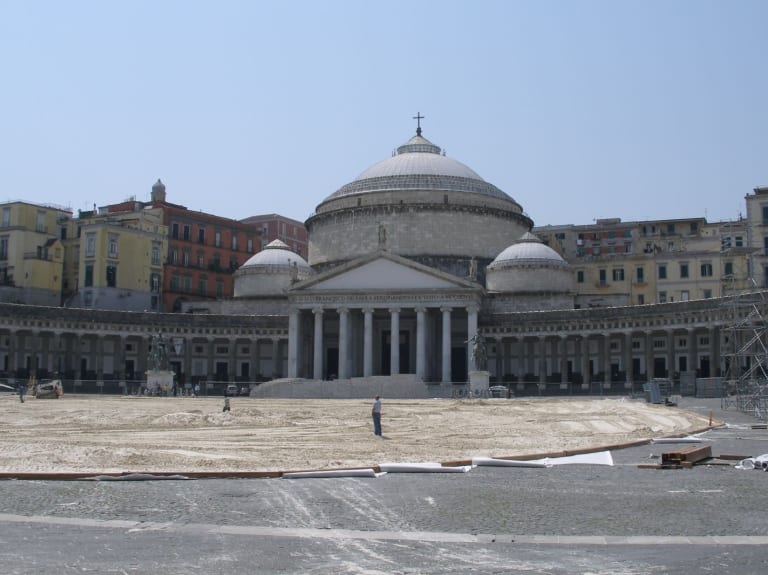
A 5-minute walk from the Galleria di Umberto I and Castel Nuovo is Piazza del Plebiscito, home to the city's historic buildings such as the Basilica of San Francesco di Paola (free admission) and the Royal Palace (approximately 6€).
While entering the buildings is an option, you can also just stroll around the square and see if you can pass the test that Queen Margherita used to give some prisoners in order to set them free. Apparently, she placed them in the middle of the square, blindfolded them, turned them around a few times and challenged them to walk in a straight line and pass between the two statues in the square. It looks easier than it is, let me know if you try it!
But you can also just have a drink around it, as it's a good place to sit and relax while you watch it.
Watch the sunset over Naples from the Egg Castle
Before the day comes to an end, head to the Egg Castle (or Castell dell'Ovo). It's about a 15-minute walk from Piazza del Plebiscito, specifically on an islet. Due to its strategic position it was the great fortification and defence of the city against attacks. Nowadays it is a cultural centre which you can access free of charge.
Wondering why it has such a strange name? Legend has it that the poet Virgil hid an egg under its foundations which, if broken, would bring misfortune to the city. I don't know if this is true, but I can assure you that, from the fortress, there are beautiful views of the Bay of Naples (and Vesuvius in the distance), especially at sunset.
Day 3: Get to know Naples Underground
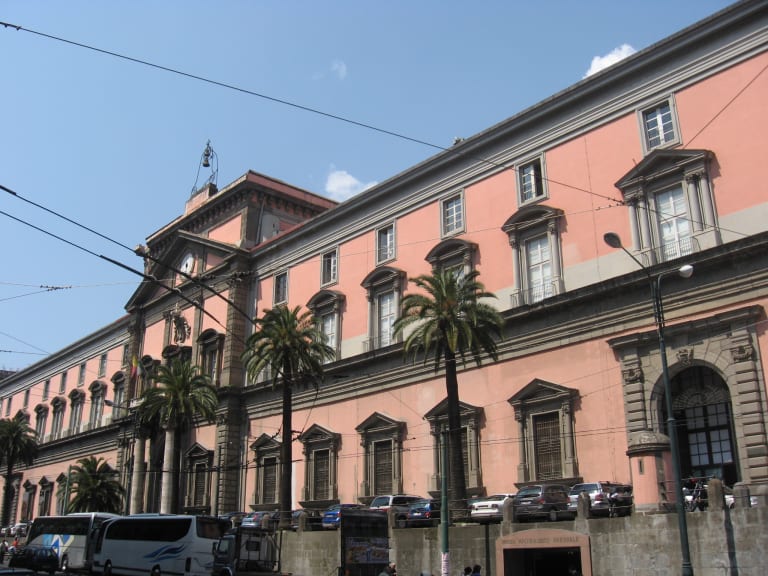
Your third day in Naples is packed with history, and for that there is no better place than the Archaeological Museum. After spending most of the morning there, I encourage you to return to the city centre for a bite to eat and to continue exploring the city's history, this time underground.
Start the day at the Naples Archaeological Museum
Start your second day with a visit to the Naples Archaeological Museum. Although it's about a 15-minute walk from the centre, just off Piazza Cavour, you may find it more convenient to get there by public transport (metro line 1 or line 2).
It is one of the best museums in Naples, so I recommend you buy a ticket and see its collections of great historical value.
There are four floors in total and the most interesting, at least for me, is the area dedicated to sculptures and objects from Roman times. Particularly interesting are the remains that were rescued from the ashes of Pompeii.
Take the opportunity to do some shopping at the Galleria Principe di Napoli
You may spend a whole morning visiting the Museum, but before going to lunch in the centre, I recommend a stop at the Galleria Principe di Napoli, which is only 5 minutes away from the museum. Access is free, but you can take the opportunity to do some shopping.
The history of the Galleria Principe di Napoli is a bit tragic, as it has never been very well cared for. In fact, as early as the beginning of the 20th century, Neapolitans were calling for the building to be restored, although it was not until well into the 21st century. Now its brick structure and glass roof is much more stable and hosts concerts and leisure activities.
Take a gastronomic tour of Spaccanapoli
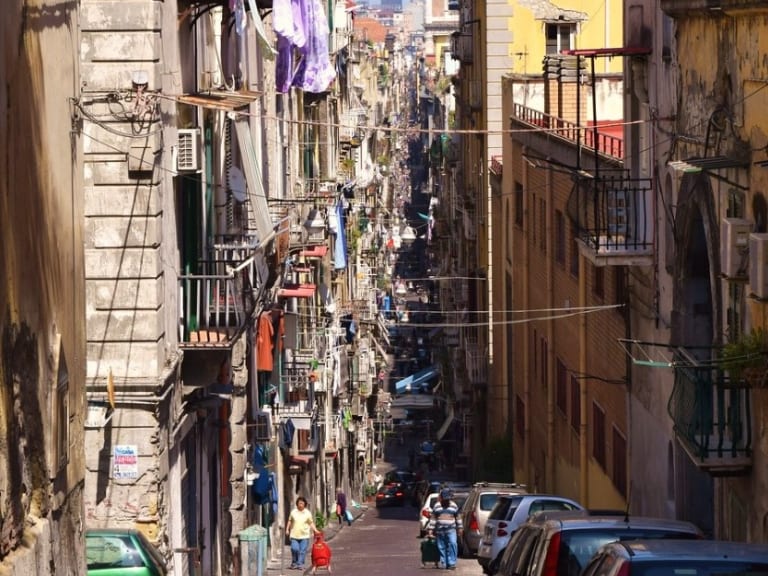
After all that history, you may have worked up an appetite. The Spaccanapoli area is one of the best places to eat. Walk down Via San Sebastiano from the Galleria Principe di Napoli towards Benedetto Croce, the first stretch of this street of streets. Once there, I recommend taking a gastronomic tour of Naples.
For about 30€ you'll enjoy the best typical food (beyond the pizzas) while a guide explains the history of the city.
The good thing about these tours is that you can be sure you're going to good places and that you'll order well. Spaccanapoli is one of the most important areas of the centre, although you could say it's actually several streets.
Go underground with a tour of Naples Underground
Can you imagine being able to visit a city underground? Get your tickets to visit Naples Underground and discover it (they cost about €10). This network of tunnels (the largest in Europe) is a 15-minute walk from the Spaccanapoli area.
It is a unique experience in which you will discover these passages that originally, during Greek times, were water reservoirs.
With the Romans their use changed and these underground tunnels became places to extract rock. Centuries went by and then came the Second World War, when they were used as shelters during the bombing raids, saving thousands of lives. Today you can visit them, walk through them and discover the bowels of Naples. Be careful, they are not for you if you suffer from claustrophobia!
Discover the ruins of the Greco-Roman Theatre of Naples
When you leave Naples Underground you will exit through the Greco-Roman Theatre, which emerges from the basement of a private house. The site you see today is Roman, although there are also remains of the earlier Greek building.
The visit is included in your Naples Underground ticket and what is most impressive about the Greco-Roman theatre (apart from the fact that it is under a house) is its marble, which decorates the entire site.
It is also known for being the place where Nero presented many of his plays and where, it is said, he did not interrupt his performance even during an earthquake.
Day 4: Discover the ruins of Pompeii and climb Mount Vesuvius

Just half an hour's drive from Naples is Pompeii, an ancient town that was devastated but preserved by the eruption of the volcano Vesuvius.
This visit is a must, so for your third day I recommend booking an excursion from Naples to Pompeii and Vesuvius, the city that was trapped in time. These tours include not only the transfer and entrance fee, but also the explanations of a specialised guide.
Pompeii Archaeological Site
Buying tickets to Pompeii and visiting it is like going back 2000 years. I know it seems impossible, but think that the lava and ashes that covered this city managed to maintain buildings, objects and even bodies for years, specifically since 79 AD, when Vesuvius erupted.
There is a lot to see and do in Pompeii. It's quite a large area, so be prepared to walk.
This city was prosperous and wealthy, although nature was never on its side (a few years before the eruption of the volcano it suffered a severe earthquake). During your visit you will be able to see for yourself and visit incredible places such as the ancient Forum, the Temple of Apollo or the Villas of the Roman nobles. Everything remains almost intact, so you'll get a pretty good idea of what life was like there.
Grab a bite to eat after your visit to Pompeii
You'll need at least the whole morning to explore the remains of this Roman city. When you have finished, I recommend you leave the site to fill your stomach. You may think that since it is a tourist site, nothing is worth it and it is better to take a sandwich with you, but there are some very good restaurants around Pompeii.
Pizza, pasta, tapas and Mediterranean menus... You'll be spoilt for choice. In the streets around the archaeological area there are plenty of places to eat well for around €25 per person. When you've finished, it's time to continue your visit and get to know the "culprit" that caused Pompeii's destruction: Vesuvius.
Climb Vesuvius and get a close-up view of the crater
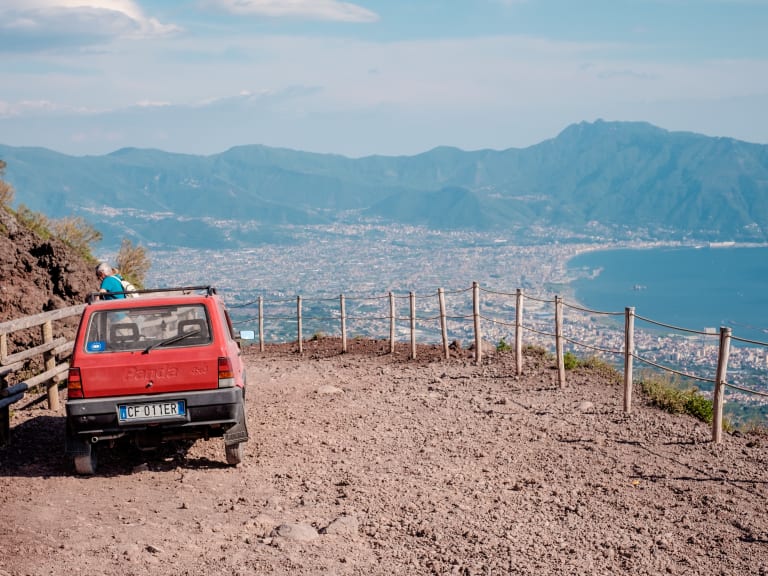
The second part of the tour consists of visiting Vesuvius. For this, if you go with an organised tour, you will go by private coach. Otherwise, you have to take the EAV bus ( about 3€ each way).
In any case, you then have to continue walking and pay for access to the top, which costs about €10, unless you have it included in the tour.
Vesuvius is one of the most dangerous volcanoes in the world, but don't worry, there hasn't been any activity on it since the 1940s. It is worth the climb to see its craters and plumes of smoke up close. Plus, at over 1,200 metres above sea level, the views of Naples are quite incredible.
Discover the area around Pompeii
While you're in the area, when you come down from Vesuvius, I recommend you stay and see the area around Pompeii. It's a beautiful area with lots of nature, you won't want to miss it! One of my favourite places is Herculaneum, a city also buried by the lava of Vesuvius.
Although it is not as well known as Pompeii, Herculaneum is also very well preserved. I recommend walking around it because it is usually less crowded. There you can find remains of Roman baths and ancient dwellings of the people who lived there.
If you also want to get to know this area in depth, I recommend you book an excursion to Pompeii that includes Herculaneum. It is not as well visited because it is less well known, but it is also well worth a visit.
Day 5: Take a trip to the Amalfi Coast
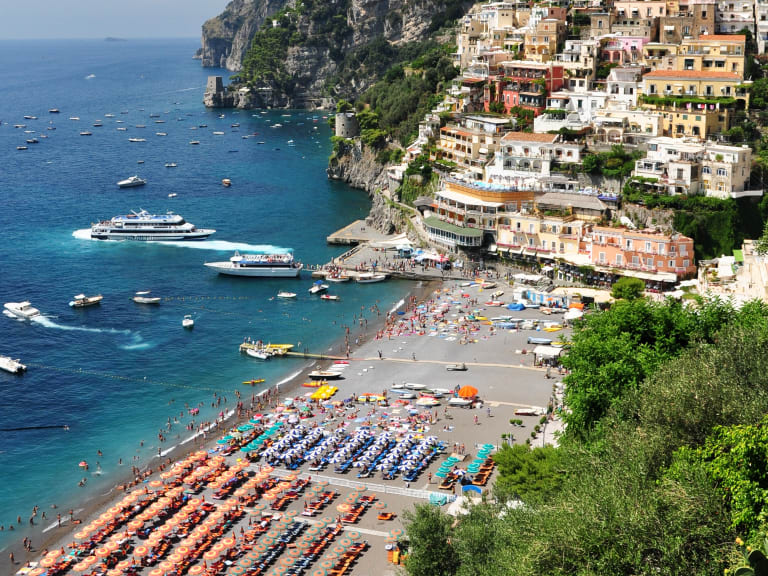
I'm sure you've already seen that the bay area of Naples is very beautiful. However, to really enjoy the beautiful beaches and traditional rocky clifftop villages, nothing beats a trip to Sorrento and the Amalfi Coast from Naples.
To get between them, it's best to go on an organised tour that includes transport to take your worries away, although you can also hire a car or take a bus combined with a train. Here's what your itinerary could be.
Start your tour in Sorrento
Start your trip along the Amalfi Coast in Sorrento, one of the most representative cities of this area.
- Climb its walls for a panoramic view of the Tyrrhenian Sea and the Bay of Naples.
- Go to the historic centre of Sorrento, made up of narrow streets with a medieval feel.
- Visit its shops and restaurants, especially in Piazza Tasso, the heart of the city.
- Nearby is the Vallone dei Mulini, an area that has been uninhabited since 1940 and is therefore like a large wild forest in the middle of the city.
Continue the journey to Positano
Just 40 minutes' drive away is Positano, your next destination and also the destination of many other tourists, as it is one of the most visited towns on the Amalfi Coast. It's no wonder, as the colourful houses and the greenery that fills the town give it an unmistakable and beautiful appearance.
The only bad thing about Positano is that there are a lot of stairs, so be prepared to go up and down a lot of them. However, it will be worth it because it means you get to see beautiful places like the Church of Santa Maria Assunta and its famous dome or the beaches.
Have lunch on the beaches of Positano
After a dip in one of Positano's beaches, what better than a bite to eat? Although the prices can be a bit expensive, being on the seafront has its advantages: the best quality fish you can imagine. I recommend you try the pasta with clams or a good seafood platter.
When you finish, before continuing your trip, you can take a stroll along the sand or lie down to rest for a while in the deckchairs that are usually available on any of the beaches. Be careful, if it's high season you'll have trouble finding a free one.
Discover the history of Amalfi

Your next stop, just over half an hour by bus from Positano, is Amalfi. As you can guess, history runs through its streets and it is also home to one of the great symbols of this area: its Duomo.
The Cathedral or Duomo of Amalfi is one of those places that you absolutely have to visit. It costs about €3 to enter and allows you to see the whole complex, which is actually two connected churches and, among other rooms, the famous Cloister of Paradise. Built with marble columns and Arab arches, it contains sarcophagi of illustrious people of the city.
End the day in Revello and climb up to its belvedere
Before returning to Naples, make one last stop in Ravello, the last town on the Amalfi Coast. It may not be as well known as the previous towns, but it has its charm. So much so that for years it has been a destination for artists of all kinds, who went there to relax.
Apart from strolling through its streets and having a drink on one of its terraces, the good thing about ending your trip in Ravello is that it will serve as the perfect farewell. For this, go to Villa Rufolo, a former noble residence that is now a cultural centre and also a viewpoint from which to observe the entire Amalfi Coast.
The best way to get around Naples

Naples is a city where the inhabitants usually go by car. However, as a tourist it is best to walk; distances are usually short within the historic centre.
If your hotel is a bit far away, you can get single tickets for public transport (about €1.10), daily passes (about €4.50) or weekly passes (about €16).
The only circumstance where it might be worth renting a car in Naples is if you plan to make several trips. The price per day is around €30, but bear in mind that driving and parking in Naples is complicated and somewhat chaotic.
Have you got everything ready? Write down the places you want to go and follow this itinerary to make sure you don't miss anything and enjoy Naples.
